check oil KIA STONIC 2018 Owners Manual
[x] Cancel search | Manufacturer: KIA, Model Year: 2018, Model line: STONIC, Model: KIA STONIC 2018Pages: 523, PDF Size: 24.99 MB
Page 150 of 523
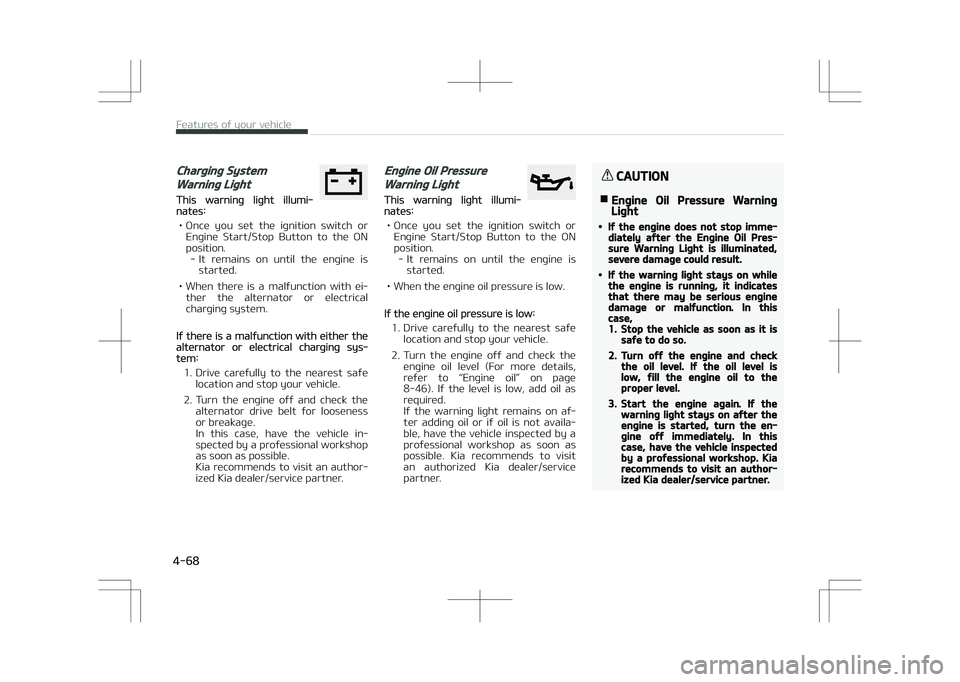
Charging System
Warning Light
This warning light illumi‐nates:
• Once you set the ignition switch or Engine Start/Stop Button to the ON
position. - It remains on until the engine is started.
• When there is a malfunction with ei‐ ther the alternator or electrical
charging system.
If there is a malfunction with either thealternator or electrical charging sys‐tem:
1. Drive carefully to the nearest safe location and stop your vehicle.
2. Turn the engine off and check the alternator drive belt for looseness
or breakage.
In this case, have the vehicle in‐
spected by a professional workshopas soon as possible.
Kia recommends to visit an author‐
ized Kia dealer/service partner.
Engine Oil Pressure
Warning Light
This warning light illumi‐nates:
• Once you set the ignition switch or Engine Start/Stop Button to the ON
position. - It remains on until the engine is started.
• When the engine oil pressure is low.
If the engine oil pressure is low:
1. Drive carefully to the nearest safe location and stop your vehicle.
2. Turn the engine off and check the engine oil level (For more details,
refer to L
Page 151 of 523
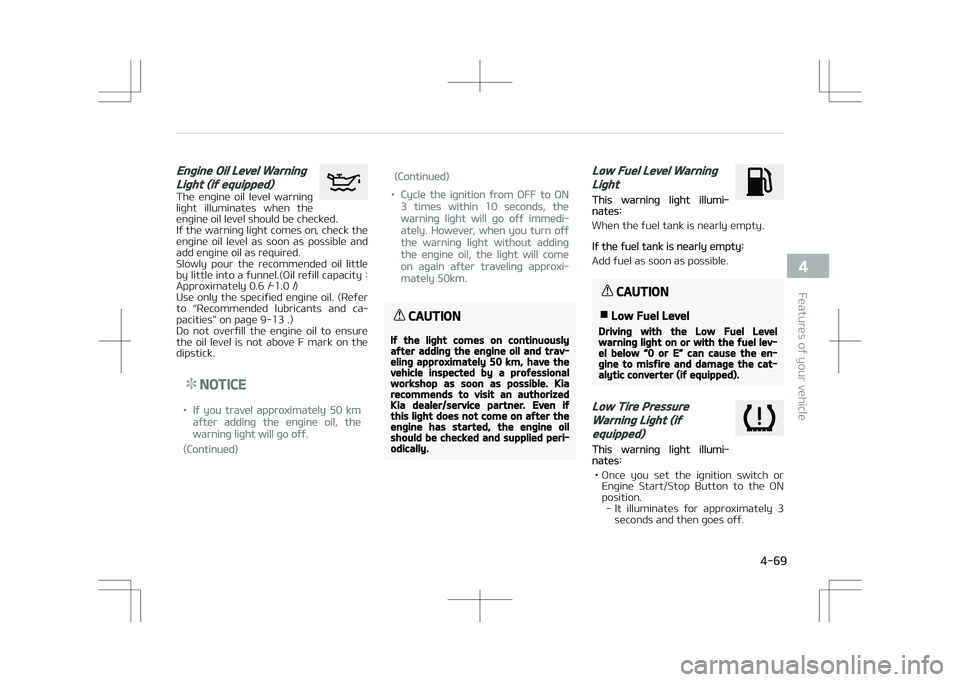
Engine Oil Level Warning
Light (if equipped)
The engine oil level warninglight illuminates when the
engine oil level should be checked.
If the warning light comes on, check the engine oil level as soon as possible and
add engine oil as required.
Slowly pour the recommended oil little
by little into a funnel.(Oil refill capacity : Approximately 0.6
l~1.0 l)
Use only the specified engine oil. (Refer
to L
Page 153 of 523
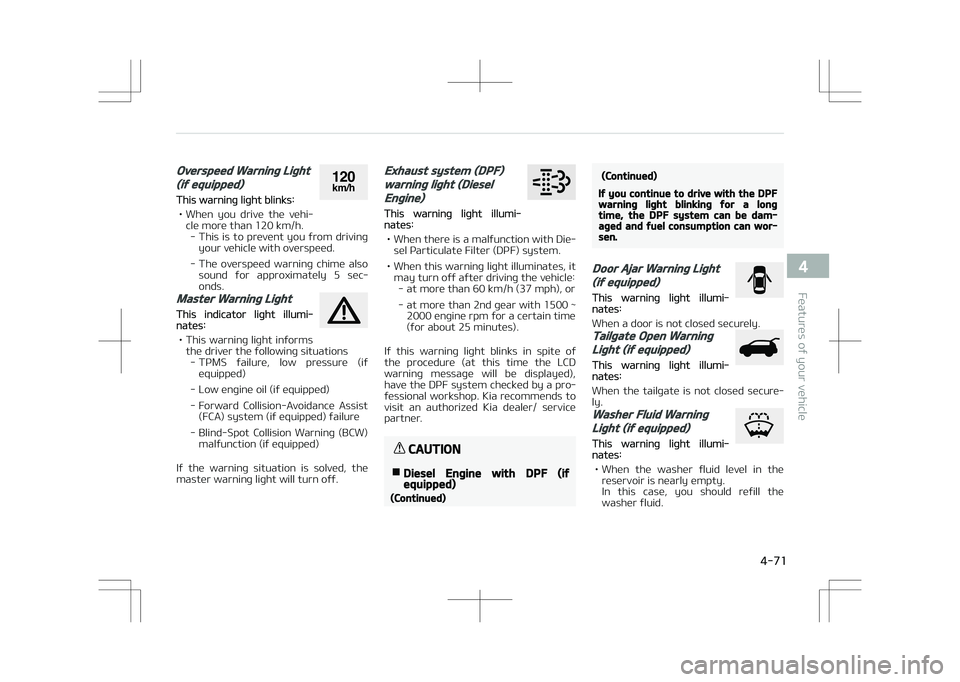
Overspeed Warning Light
(if equipped)
This warning light blinks:
• When you drive the vehi‐ cle more than 120 km/h.- This is to prevent you from driving your vehicle with overspeed.
- The overspeed warning chime also sound for approximately 5 sec‐ onds.
120km/h
Master Warning Light
This indicator light illumi‐nates:
• This warning light informs the driver the following situations- TPMS failure, low pressure (if equipped)
- Low engine oil (if equipped)
- Forward Collision-Avoidance Assist (FCA) system (if equipped) failure
- Blind-Spot Collision Warning (BCW) malfunction (if equipped)
If the warning situation is solved, the master warning light will turn off.
Exhaust system (DPF)
warning light (Diesel
Engine)
This warning light illumi‐nates:
• When there is a malfunction with Die‐ sel Particulate Filter (DPF) system.
• When this warning light illuminates, it may turn off after driving the vehicle:- at more than 60 km/h (37 mph), or
- at more than 2nd gear with 1500 ~ 2000 engine rpm for a certain time (for about 25 minutes).
If this warning light blinks in spite of
the procedure (at this time the LCD warning message will be displayed),
have the DPF system checked by a pro‐
fessional workshop. Kia recommends to visit an authorized Kia dealer/ service
partner.
CAUTION
nDiesel Engine with DPF (ifequipped)
(Continued)
(Continued)
If you continue to drive with the DPFwarning light blinking for a longtime, the DPF system can be dam‐aged and fuel consumption can wor‐sen.
Door Ajar Warning Light
(if equipped)
This warning light illumi‐nates:
When a door is not closed securely.
Tailgate Open Warning
Light (if equipped)
This warning light illumi‐nates:
When the tailgate is not closed secure‐
ly.
Washer Fluid Warning
Light (if equipped)
This warning light illumi‐nates:
• When the washer fluid level in the reservoir is nearly empty.
In this case, you should refill the
washer fluid.
4-71
4
Features of your vehicle
Page 224 of 523
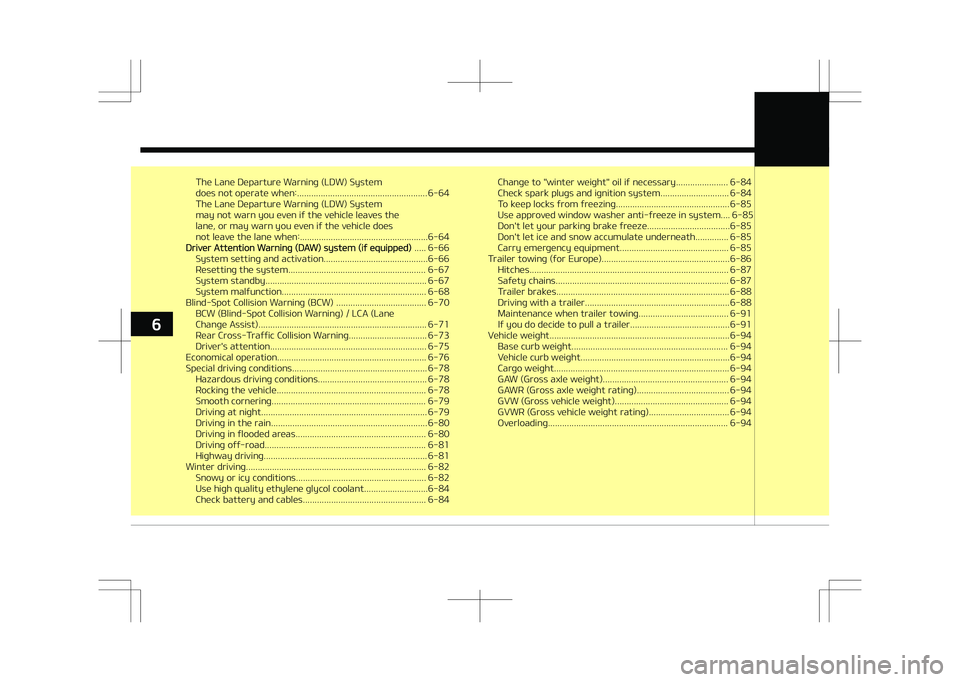
The Lane Departure Warning (LDW) System
does not operate when:....................................................... 6-64
The Lane Departure Warning (LDW) System
may not warn you even if the vehicle leaves the
lane, or may warn you even if the vehicle does
not leave the lane when:......................................................6-64
Driver Attention Warning (DAW) system (if equipped) ..... 6-66
System setting and activation............................................6-66
Resetting the system.......................................................... 6-67
System standby.................................................................... 6-67
System malfunction............................................................. 6-68
Blind-Spot Collision Warning (BCW) ...................................... 6-70 BCW (Blind-Spot Collision Warning) / LCA (Lane
Change Assist)....................................................................... 6-71
Rear Cross-Traffic Collision Warning................................. 6-73
Driver's attention.................................................................. 6-75
Economical operation............................................................... 6-76
Special driving conditions......................................................... 6-78 Hazardous driving conditions.............................................. 6-78
Rocking the vehicle............................................................... 6-78
Smooth cornering................................................................. 6-79
Driving at night...................................................................... 6-79
Driving in the rain.................................................................. 6-80
Driving in flooded areas....................................................... 6-80
Driving off-road.................................................................... 6-81
Highway driving..................................................................... 6-81
Winter driving............................................................................ 6-82 Snowy or icy conditions....................................................... 6-82
Use high quality ethylene glycol coolant...........................6-84
Check battery and cables.................................................... 6-84 Change to "winter weight" oil if necessary...................... 6-84
Check spark plugs and ignition system............................. 6-84
To keep locks from freezing................................................ 6-85
Use approved window washer anti-freeze in system.... 6-85
Don't let your parking brake freeze...................................6-85
Don't let ice and snow accumulate underneath.............. 6-85
Carry emergency equipment.............................................. 6-85
Trailer towing (for Europe)...................................................... 6-86 Hitches.................................................................................... 6-87
Safety chains......................................................................... 6-87
Trailer brakes......................................................................... 6-88
Driving with a trailer............................................................. 6-88
Maintenance when trailer towing...................................... 6-91
If you do decide to pull a trailer.......................................... 6-91
Vehicle weight............................................................................ 6-94 Base curb weight.................................................................. 6-94
Vehicle curb weight...............................................................6-94
Cargo weight.......................................................................... 6-94
GAW (Gross axle weight)..................................................... 6-94
GAWR (Gross axle weight rating)....................................... 6-94
GVW (Gross vehicle weight)................................................ 6-94
GVWR (Gross vehicle weight rating).................................. 6-94
Overloading............................................................................ 6-94
6
Page 225 of 523
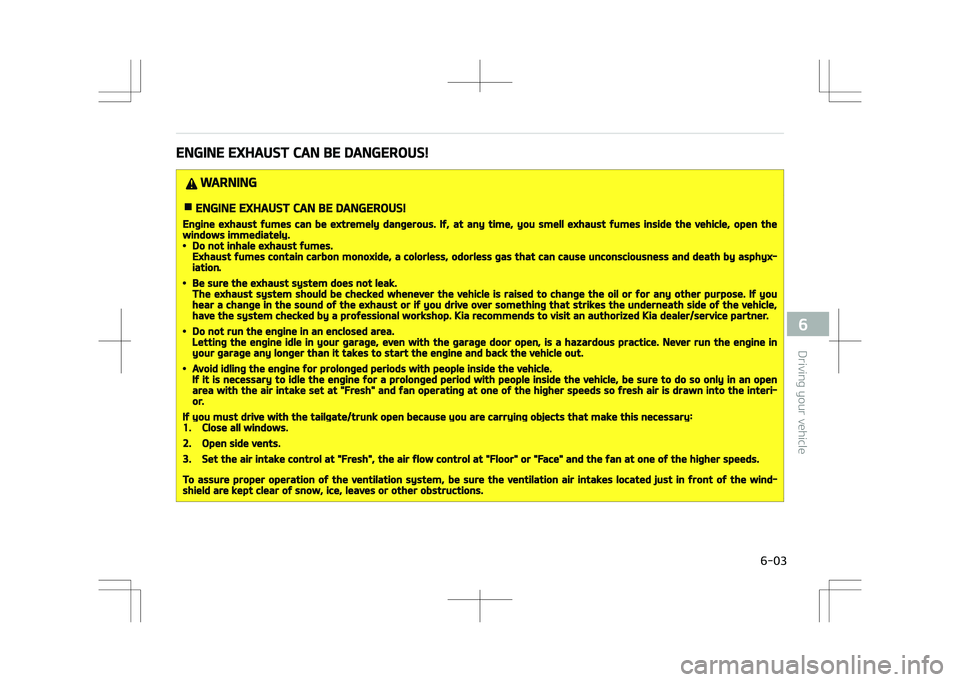
ENGINE EXHAUST CAN BE DANGEROUS!
WARNING
nENGINE EXHAUST CAN BE DANGEROUS!
Engine exhaust fumes can be extremely dangerous. If, at any time, you smell exhaust fumes inside the vehicle, open thewindows immediately.•Do not inhale exhaust fumes.Exhaust fumes contain carbon monoxide, a colorless, odorless gas that can cause unconsciousness and death by asphyx‐iation.
•Be sure the exhaust system does not leak.The exhaust system should be checked whenever the vehicle is raised to change the oil or for any other purpose. If youhear a change in the sound of the exhaust or if you drive over something that strikes the underneath side of the vehicle,have the system checked by a professional workshop. Kia recommends to visit an authorized Kia dealer/service partner.
•Do not run the engine in an enclosed area.Letting the engine idle in your garage, even with the garage door open, is a hazardous practice. Never run the engine inyour garage any longer than it takes to start the engine and back the vehicle out.
•Avoid idling the engine for prolonged periods with people inside the vehicle.If it is necessary to idle the engine for a prolonged period with people inside the vehicle, be sure to do so only in an openarea with the air intake set at "Fresh" and fan operating at one of the higher speeds so fresh air is drawn into the interi‐or.
If you must drive with the tailgate/trunk open because you are carrying objects that make this necessary:1.Close all windows.
2.Open side vents.
3.Set the air intake control at "Fresh", the air flow control at "Floor" or "Face" and the fan at one of the higher speeds.
To assure proper operation of the ventilation system, be sure the ventilation air intakes located just in front of the wind‐shield are kept clear of snow, ice, leaves or other obstructions.
6-03
6
Driving your vehicle
Page 226 of 523

BEFORE DRIVING
Before entering vehicle
• Be sure that all windows, outsidemirror(s), and outside lights are clean.
• Check the condition of the tires.
• Check under the vehicle for any sign of leaks.
• Be sure there are no obstacles behind you if you intend to back up.
Necessary inspections
Fluid levels, such as engine oil, engine
coolant, brake fluid, and washer fluid should be checked on a regular basis,
with the exact interval depending on
the fluid. Further details are provided in L
Page 313 of 523
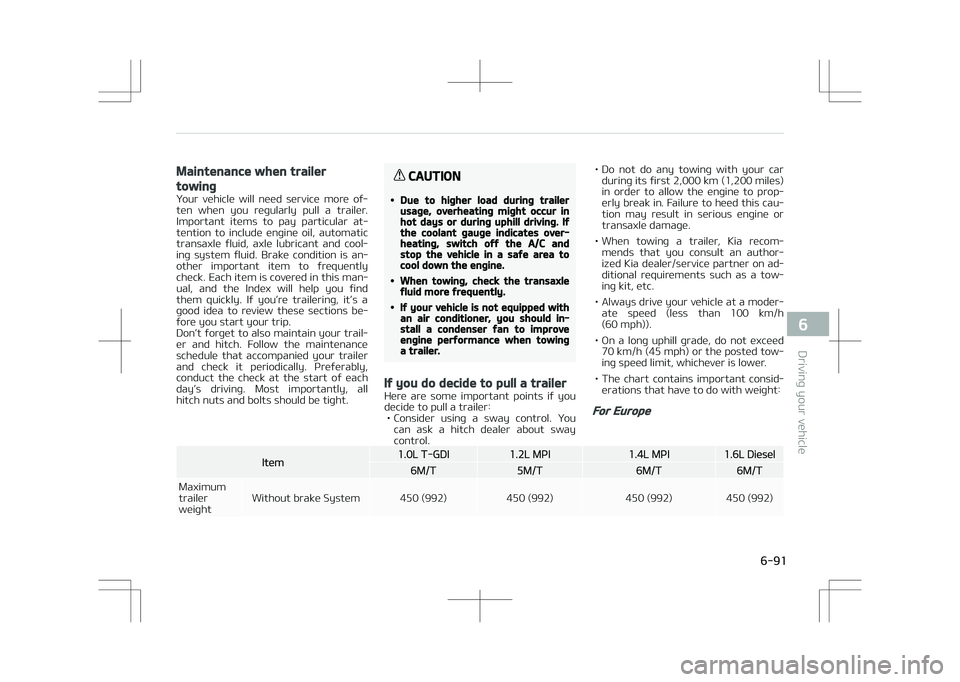
Maintenance when trailer
towing
Your vehicle will need service more of‐
ten when you regularly pull a trailer.
Important items to pay particular at‐ tention to include engine oil, automatic
transaxle fluid, axle lubricant and cool‐
ing system fluid. Brake condition is an‐ other important item to frequently
check. Each item is covered in this man‐
ual, and the Index will help you find them quickly. If you’re trailering, it’s a
good idea to review these sections be‐
fore you start your trip.
Don’t forget to also maintain your trail‐ er and hitch. Follow the maintenance
schedule that accompanied your trailer
and check it periodically. Preferably, conduct the check at the start of each
day’s driving. Most importantly, all
hitch nuts and bolts should be tight.
CAUTION
•Due to higher load during trailerusage, overheating might occur inhot days or during uphill driving. Ifthe coolant gauge indicates over‐heating, switch off the A/C andstop the vehicle in a safe area tocool down the engine.
•When towing, check the transaxlefluid more frequently.
•If your vehicle is not equipped withan air conditioner, you should in‐stall a condenser fan to improveengine performance when towinga trailer.
If you do decide to pull a trailer
Here are some important points if you
decide to pull a trailer:
• Consider using a sway control. You can ask a hitch dealer about swaycontrol. • Do not do any towing with your car
during its first 2,000 km (1,200 miles)
in order to allow the engine to prop‐
erly break in. Failure to heed this cau‐
tion may result in serious engine or transaxle damage.
• When towing a trailer, Kia recom‐ mends that you consult an author‐
ized Kia dealer/service partner on ad‐
ditional requirements such as a tow‐
ing kit, etc.
• Always drive your vehicle at a moder‐ ate speed (less than 100 km/h
(60 mph)).
• On a long uphill grade, do not exceed 70 km/h (45 mph) or the posted tow‐
ing speed limit, whichever is lower.
• The chart contains important consid‐ erations that have to do with weight:
For Europe
Item1.0L T-GDI1.2L MPI1.4L MPI1.6L Diesel
6M/T5M/T6M/T6M/T
Maximum trailerweight Without brake System 450 (992) 450 (992) 450 (992) 450 (992)
6-91
6
Driving your vehicle
Page 347 of 523
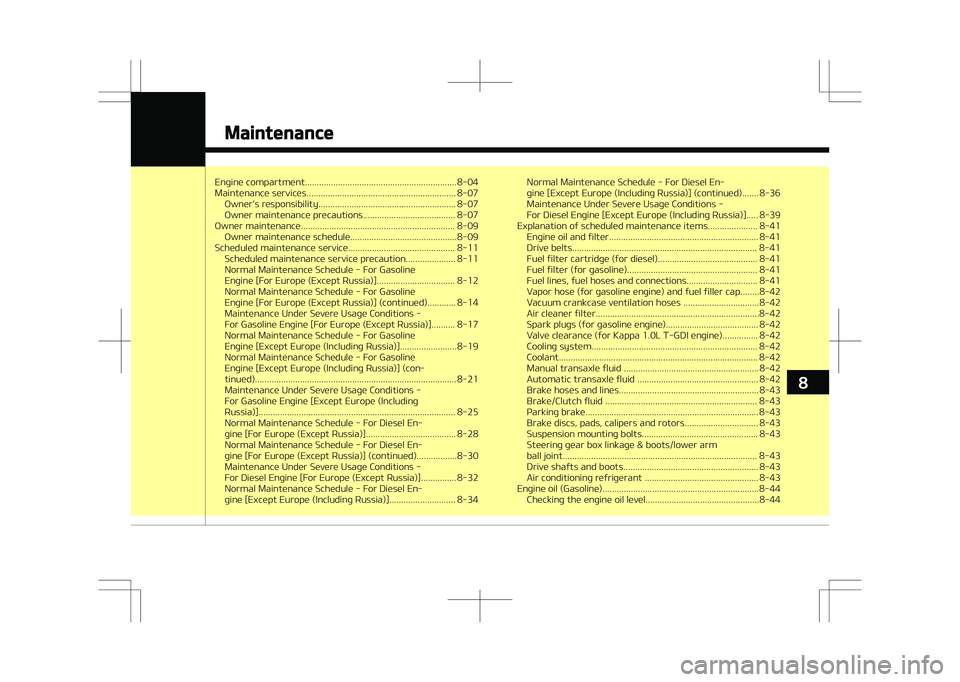
Engine compartment................................................................ 8-04
Maintenance services............................................................... 8-07Owner’s responsibility.......................................................... 8-07
Owner maintenance precautions....................................... 8-07
Owner maintenance................................................................. 8-09 Owner maintenance schedule.............................................8-09
Scheduled maintenance service............................................. 8-11 Scheduled maintenance service precaution..................... 8-11
Normal Maintenance Schedule - For Gasoline
Engine [For Europe (Except Russia)]................................. 8-12
Normal Maintenance Schedule - For Gasoline
Engine [For Europe (Except Russia)] (continued)............ 8-14
Maintenance Under Severe Usage Conditions -
For Gasoline Engine [For Europe (Except Russia)].......... 8-17
Normal Maintenance Schedule - For Gasoline
Engine [Except Europe (Including Russia)]........................8-19
Normal Maintenance Schedule - For Gasoline
Engine [Except Europe (Including Russia)] (con‐
tinued)..................................................................................... 8-21
Maintenance Under Severe Usage Conditions -
For Gasoline Engine [Except Europe (Including
Russia)]................................................................................... 8-25
Normal Maintenance Schedule - For Diesel En‐
gine [For Europe (Except Russia)]...................................... 8-28
Normal Maintenance Schedule - For Diesel En‐
gine [For Europe (Except Russia)] (continued).................8-30
Maintenance Under Severe Usage Conditions -
For Diesel Engine [For Europe (Except Russia)]............... 8-32
Normal Maintenance Schedule - For Diesel En‐
gine [Except Europe (Including Russia)]............................ 8-34 Normal Maintenance Schedule - For Diesel En‐
gine [Except Europe (Including Russia)] (continued)....... 8-36
Maintenance Under Severe Usage Conditions -
For Diesel Engine [Except Europe (Including Russia)]..... 8-39
Explanation of scheduled maintenance items..................... 8-41 Engine oil and filter............................................................... 8-41
Drive belts.............................................................................. 8-41
Fuel filter cartridge (for diesel).......................................... 8-41
Fuel filter (for gasoline)....................................................... 8-41
Fuel lines, fuel hoses and connections.............................. 8-41
Vapor hose (for gasoline engine) and fuel filler cap........8-42
Vacuum crankcase ventilation hoses ................................8-42
Air cleaner filter.....................................................................8-42
Spark plugs (for gasoline engine)....................................... 8-42
Valve clearance (for Kappa 1.0L T-GDI engine)............... 8-42
Cooling system...................................................................... 8-42
Coolant.................................................................................... 8-42
Manual transaxle fluid .........................................................8-42
Automatic transaxle fluid ................................................... 8-42
Brake hoses and lines........................................................... 8-43
Brake/Clutch fluid ................................................................ 8-43
Parking brake......................................................................... 8-43
Brake discs, pads, calipers and rotors............................... 8-43
Suspension mounting bolts................................................. 8-43Steering gear box linkage & boots/lower arm
ball joint.................................................................................. 8-43
Drive shafts and boots......................................................... 8-43
Air conditioning refrigerant ................................................ 8-43
Engine oil (Gasoline)..................................................................8-44 Checking the engine oil level................................................8-44
Maintenance
8
Page 348 of 523
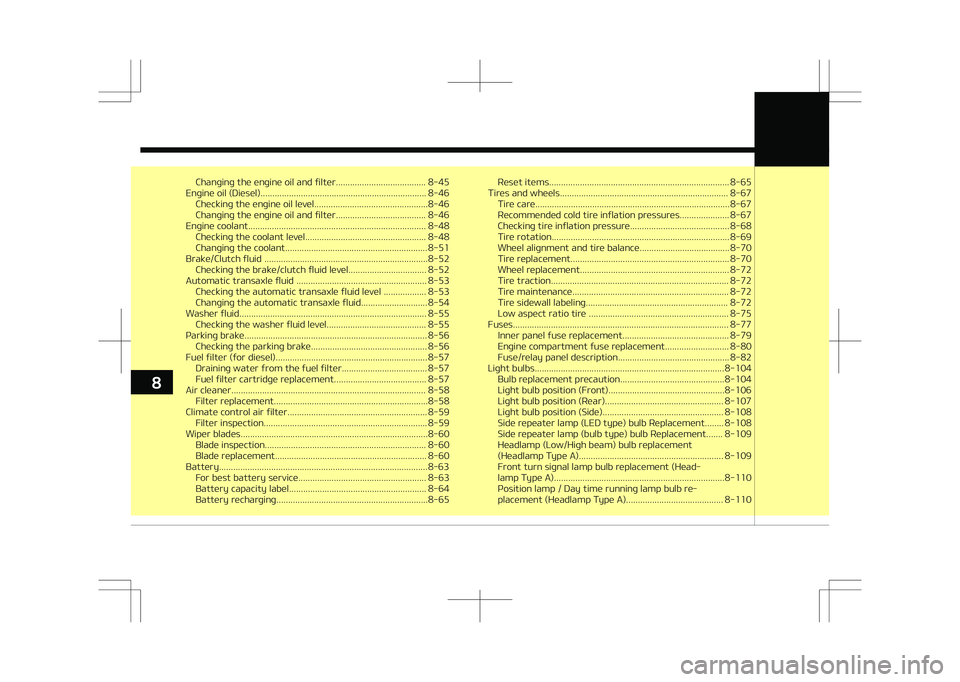
Changing the engine oil and filter...................................... 8-45
Engine oil (Diesel)...................................................................... 8-46 Checking the engine oil level................................................8-46
Changing the engine oil and filter...................................... 8-46
Engine coolant........................................................................... 8-48 Checking the coolant level................................................... 8-48
Changing the coolant............................................................ 8-51
Brake/Clutch fluid .....................................................................8-52 Checking the brake/clutch fluid level................................. 8-52
Automatic transaxle fluid ....................................................... 8-53 Checking the automatic transaxle fluid level .................. 8-53
Changing the automatic transaxle fluid............................ 8-54
Washer fluid............................................................................... 8-55 Checking the washer fluid level.......................................... 8-55
Parking brake............................................................................. 8-56 Checking the parking brake................................................. 8-56
Fuel filter (for diesel)................................................................ 8-57 Draining water from the fuel filter.................................... 8-57
Fuel filter cartridge replacement....................................... 8-57
Air cleaner.................................................................................. 8-58 Filter replacement.................................................................8-58
Climate control air filter........................................................... 8-59 Filter inspection..................................................................... 8-59
Wiper blades...............................................................................8-60 Blade inspection.................................................................... 8-60
Blade replacement................................................................ 8-60
Battery........................................................................................8-63 For best battery service...................................................... 8-63
Battery capacity label.......................................................... 8-64
Battery recharging................................................................8-65 Reset items............................................................................ 8-65
Tires and wheels....................................................................... 8-67 Tire care.................................................................................. 8-67
Recommended cold tire inflation pressures..................... 8-67
Checking tire inflation pressure.......................................... 8-68
Tire rotation........................................................................... 8-69
Wheel alignment and tire balance...................................... 8-70
Tire replacement................................................................... 8-70
Wheel replacement............................................................... 8-72
Tire traction........................................................................... 8-72
Tire maintenance.................................................................. 8-72
Tire sidewall labeling............................................................ 8-72
Low aspect ratio tire ........................................................... 8-75
Fuses........................................................................................... 8-77 Inner panel fuse replacement............................................. 8-79
Engine compartment fuse replacement........................... 8-80
Fuse/relay panel description............................................... 8-82
Light bulbs................................................................................8-104 Bulb replacement precaution............................................8-104
Light bulb position (Front).................................................8-106
Light bulb position (Rear).................................................. 8-107
Light bulb position (Side)................................................... 8-108
Side repeater lamp (LED type) bulb Replacement........ 8-108
Side repeater lamp (bulb type) bulb Replacement....... 8-109
Headlamp (Low/High beam) bulb replacement
(Headlamp Type A)............................................................. 8-109
Front turn signal lamp bulb replacement (Head‐
lamp Type A)........................................................................8-110
Position lamp / Day time running lamp bulb re‐
placement (Headlamp Type A)......................................... 8-110
8
Page 354 of 523
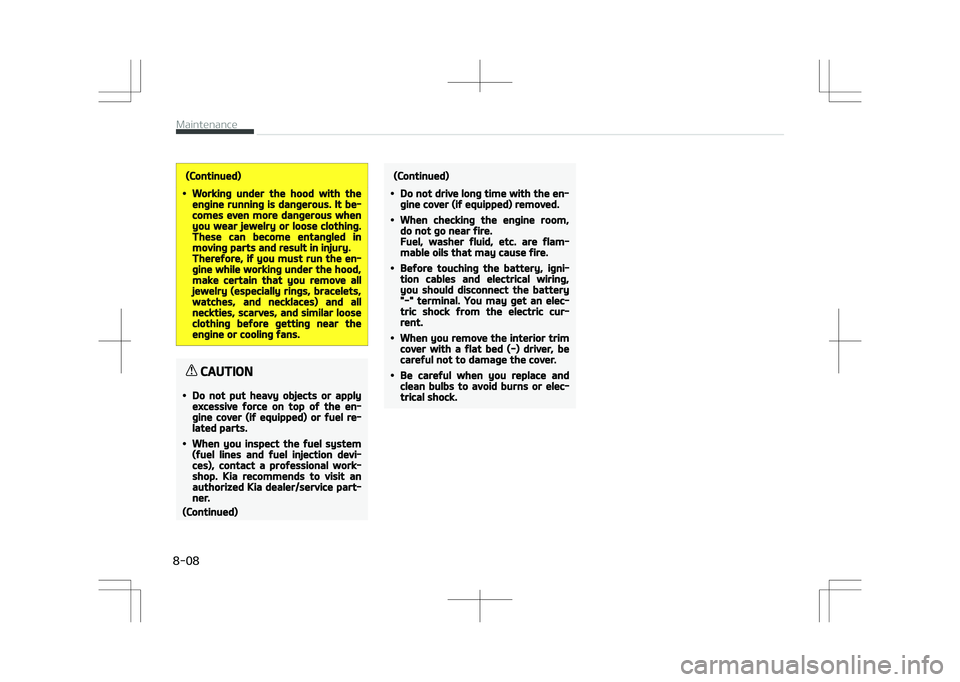
(Continued)
•Working under the hood with theengine running is dangerous. It be‐comes even more dangerous whenyou wear jewelry or loose clothing.These can become entangled inmoving parts and result in injury.Therefore, if you must run the en‐gine while working under the hood,make certain that you remove alljewelry (especially rings, bracelets,watches, and necklaces) and allneckties, scarves, and similar looseclothing before getting near theengine or cooling fans.
CAUTION
•Do not put heavy objects or applyexcessive force on top of the en‐gine cover (if equipped) or fuel re‐lated parts.
•When you inspect the fuel system(fuel lines and fuel injection devi‐ces), contact a professional work‐shop. Kia recommends to visit anauthorized Kia dealer/service part‐ner.
(Continued)
(Continued)
•Do not drive long time with the en‐gine cover (if equipped) removed.
•When checking the engine room,do not go near fire.Fuel, washer fluid, etc. are flam‐mable oils that may cause fire.
•Before touching the battery, igni‐tion cables and electrical wiring,you should disconnect the battery"-" terminal. You may get an elec‐tric shock from the electric cur‐rent.
•When you remove the interior trimcover with a flat bed (-) driver, becareful not to damage the cover.
•Be careful when you replace andclean bulbs to avoid burns or elec‐trical shock.
Maintenance
8-08